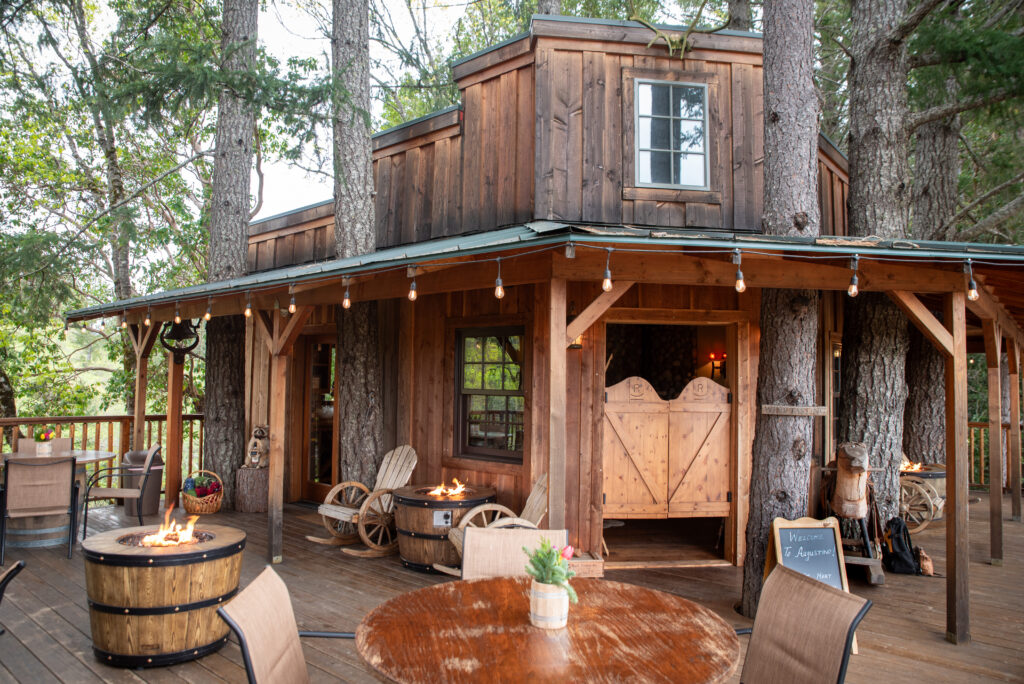7 Reasons to Love Winter Hiking


While many associate hiking with warm weather and sunny days, those of us who hike year round know winter offers its own unique adventures and benefits. There’s something magical about the mist hugging the mountains, moss blanketing trees and boulders, and waterfalls cascading down to seasonal creeks. With Southern Oregon’s temperate climate, you can find warmer hikes down in the valley or head up the mountain to hike in the snow. 1. Less Crowds, More Trail
1. Less Crowds, More Trail
For those seeking peace and quiet while venturing out in nature, winter is by far the calmest time on the trails. Popular hikes that can be hard to find parking much of the year become empty lots during the winter time, guaranteeing solitude and stillness until spring awakens. Take advantage of Oregon’s quietest season and plan a hike at Lower Table Rock, just 30 minutes from downtown Grants Pass. The volcanic mesa hovers 800ft above the valley floor and offers hikers incredible long range views of Mt McLoughlin, Mt Ashland Ski Area, and the rim of Crater Lake National Park.
Take advantage of Oregon’s quietest season and plan a hike at Lower Table Rock, just 30 minutes from downtown Grants Pass. The volcanic mesa hovers 800ft above the valley floor and offers hikers incredible long range views of Mt McLoughlin, Mt Ashland Ski Area, and the rim of Crater Lake National Park.
 2. Bigger Waterfalls
2. Bigger Waterfalls
By the middle to end of summer, rushing waterfalls become meager trickles throughout much of Southern Oregon. However, winter’s rain and high elevation snow replenishes rivers and seasonal creeks, promising much larger waterfalls. This winter, explore local waterfalls like the ones along Limpy Creek Botanical Trail and Applegate’s Middle Fork or head up towards Prospect and hike to Pearsony, National Creek, Mill Creek, and Barr Falls.
 3. Winter’s Lushness
3. Winter’s Lushness
While much of the country turns into a grey scale during winter, Grants Pass has so much year round foliage, from Douglas Firs to Madrones, and Manzanita, you’ll find plenty of greenery throughout winter. Not only that, but during the wet season, brilliant moss blankets the landscape, covering trees, boulders, and creeksides. While there are plenty of evergreens, the trees that do lose their leaves reveal something you rarely see during summer- vibrant lichen. While tree canopies usually hide these opportunistic forest dwellers from spring to fall, only during winter can we see them growing on trees, rocks, and even the soil. Often confused with Spanish moss, lace lichen can be seen hanging from branches and bark, creating an eerily beautiful scene. Unlike moss, lichens are actually a symbiotic partnership of two different organisims- fungus and algae. They have many benefits too, from being a food source for wildlife to purifying the air. Additionally lichens have been used by indigenous communities, including the local Takelma for thousands of years, providing medicine, bedding, and a food source during harsh winter months. Some great local hikes to see this is along the Waters Creek Trail and the Enchanted Forest Trail.
 4. No Bugs
4. No Bugs
There’s no bigger buzz kill than attempting a drop dead gorgeous hike only to be eaten alive by mosquitos. If you’ve explored high elevation lakes or meadows during the summer in Oregon- the bugs can be legendary! During winter, you can leave the bug spray and nets at home because the only thing you’ll see flying are birds and occasional raindrops. Although cave tours are on hold until late spring, Oregon Caves National Monument is open to visitors all year long. With a multitude of hiking trails, bring some snow shoes and enjoy a day in winter wonderland. Keep in mind, this is a higher elevation destination and snow storms can occasionally close the road, so check the road conditions and weather first and bring chains and traction tires. Here, you are guaranteed to run into snow, and a lot of it—so pack extra layers and come prepared.
 5. Winter Mushrooms Are a Thing
5. Winter Mushrooms Are a Thing
While spring and fall are generally regarded as prime time for mushroom foragers, winter presents its own share of amazing mushrooms——- if you know what to look for. While temperatures are typically too cold for most fungi to appear, there are some exceptions. Winter Chanterelles, Oysters, Black Trumpets, Lion’s Mane, Hedgehogs, and the prized Truffles can be found throughout the winter months. Keep in mind, consuming wild mushrooms can be dangerous for those without experience, so make sure you can properly identify mushrooms before diving in. If you’re interested in learning about mushrooms, but would like an expert’s help, hire a local foraging guide and check out courses offered at Siskiyou Field Institute.
 6.GORGEous Photo Ops
6.GORGEous Photo Ops
Though Oregon’s scenery is epic year-round, there’s something extra special about frost tipped trees and moody mist that hugs the mountains during wintertime. For those who don’t mind bundling up, head up the mountain where snow adds an extra element of awesome to the landscape. The stark white snow juxtaposed with the forest’s vibrant greens along the Upper Rogue River Trail are a sight to behold. Take a day trip to Prospect and plan a hike to Takelma Gorge. After parking at the Woodruff Bridge Day Use Area, follow the trail downriver for 1.6miles until reaching the gorge which showcases stunning volcanic geology.
 7. Winter Hikes Are More Pet-Friendly
7. Winter Hikes Are More Pet-Friendly
If you have a 4-legged buddy joining your adventures, winter is a great time to hike with pets. While hot summers mean hauling extra water and taking shorter hikes, you don’t have to worry about heat strokes on the trail during winter. With more water sources along the hike and cooler temps, furry pals can enjoy the hike just as much as you do. Head to Applegate Valley and explore 21 miles of trail along the Sterling Ditch Mine Trail. The hike offers panoramic views as well as interesting history of Southern Oregon’s gold rush days. While hiking its vast network of trails, make sure to take the Tunnel Ridge/ Bear Gulch Loop and check out the historic Sterling Mine Ditch and tunnel. Located near Jacksonville, the tunnel and ditch which was dug in the 1880s, supplied water for mining operations from the Little Applegate River. Afterwards, make sure to drop by Buncom Ghost Town, where you can see the remaining buildings left behind from Oregon’s mining boom. Learn more about the valley’s mining history and neat points of interest on our blog.

But wait…. there’s more! If that wasn’t enough to entice you to hike this winter, check out our blog about amazing winter hikes and more wintertime adventures around the Rogue Valley. Before venturing out on your next winter escapade, double check weather and road conditions along your route on Tripcheck. While the weather stays relatively mild in the Rogue Valley, high elevation passes see plenty of snow, including those along I-5. Be aware of chain requirements, bring extra clothing and supplies, and make sure your vehicle is winter-ready. With the proper precautions, Southern Oregon offers wintertime adventurers the best of both worlds and an exciting place to enjoy the outdoors.




